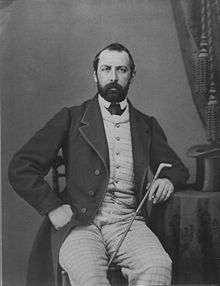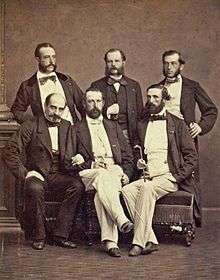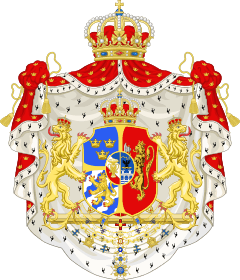Charles XV of Sweden
| Charles XV & IV | |||||
|---|---|---|---|---|---|
 Charles XV photographed by Mathias Hansen around 1865 | |||||
| King of Sweden and Norway | |||||
| Reign | 8 July 1859 – 18 September 1872 | ||||
| Coronations |
3 May 1860, Stockholm 5 August 1860, Trondheim | ||||
| Predecessor | Oscar I | ||||
| Successor | Oscar II | ||||
| Born |
3 May 1826 Stockholm, Sweden | ||||
| Died |
18 September 1872 (aged 46) Malmö, Sweden | ||||
| Burial |
9 October 1872 Riddarholmskyrkan, Stockholm | ||||
| Spouse | Louise of the Netherlands | ||||
| Issue |
Louise, Queen of Denmark Prince Carl Oscar, Duke of Södermanland | ||||
| |||||
| House | Bernadotte | ||||
| Father | Oscar I | ||||
| Mother | Josephine of Leuchtenberg | ||||
| Religion | Church of Sweden | ||||
Charles XV & IV also Carl (Carl Ludvig Eugen); Swedish: Karl XV and Norwegian: Karl IV (3 May 1826 – 18 September 1872) was King of Sweden (Charles XV) and Norway (Charles IV) from 1859 until his death. Though known as King Charles XV in Sweden (and also on contemporary Norwegian coins[1]), he was actually the ninth Swedish king by that name, as his predecessor Charles IX (reigned 1604–1611) had adopted a numeral according to a fictitious history of Sweden.[2]
Biography


Early life
He was born in Stockholm Palace, Stockholm in 1826 and dubbed Duke of Scania at birth. Born the eldest son of Crown Prince Oscar of Sweden and his consort Crown Princess Josephine, he would be second in line to the throne of his grandfather, the ruling King Charles XIV of Sweden. During his childhood he was placed in the care of the royal governess countess Christina Ulrika Taube.[3]. When he was just 15, he was given his first officer's commission in 1841 by his grandfather the king.
Crown Prince
The aging King Charles XIV would suffer a stroke on his 81st birthday in 1844, dying little more than a month later. His successor would be his son, Charles’s father Oscar, who ascended the throne as King Oscar I of Sweden. Upon his father's accession to the throne in 1844, the youth Charles was made a chancellor of the universities of Uppsala and Lund, and in 1853 chancellor of Royal Swedish Academy of Arts. On 11 February 1846 he was made an honorary member of the Royal Swedish Academy of Sciences.[4]
The Crown Prince was Viceroy of Norway briefly in 1856 and 1857. He became Regent on 25 September 1857, and king on the death of his father on 8 July 1859. As grandson of Augusta of Bavaria, he was a descendant of Gustav I of Sweden and Charles IX of Sweden, whose blood returned to the throne after being lost in 1818 when Charles XIII of Sweden died.
On 19 June 1850 he married in Stockholm Louise of the Netherlands, niece of William II of the Netherlands through her father and niece of William I of Prussia, German Emperor, through her mother. The couple were personally quite dissimilar; Louise was a cultured and refined woman, however, she was considered to be quite plain and Charles was disappointed with her appearance. Louise was in love with her husband, whereas he preferred other women, saddening her deeply. His well-known mistresses included the actress Laura Bergnéhr, the countess Josephine Sparre, Wilhelmine Schröder and the actresses Hanna Styrell and Elise Hwasser, and the Crown Prince neglected his shy wife. On the other hand, his relationship to his only daughter, Louise, was warm and close.[5]
Regency
As Crown Prince, Charles' brusque manner led many to regard his future accession with some apprehension, yet he proved to be one of the most popular of Scandinavian kings and a constitutional ruler in the best sense of the word. His reign was remarkable for its manifold and far-reaching reforms. Sweden's existing municipal law (1862), ecclesiastical law (1863) and criminal law (1864) were enacted appropriately enough under the direction of a king whose motto was: Land skall med lag byggas - "With law shall the land be built". Charles also helped Louis De Geer to carry through his reform of the Parliament of Sweden in 1866. He also declared the freedom of women by passing the law of legal majority for unmarried women in 1858 – his sister Princess Eugenie became the first woman who was declared mature.[6]
Charles, like his father Oscar I, was an advocate of Scandinavianism and the political solidarity of the three northern kingdoms, and his friendship with Frederick VII of Denmark, it is said, led him to give half promises of help to Denmark on the eve of the war of 1864, which, in the circumstances, were perhaps misleading and unjustifiable. In view, however, of the unpreparedness of the Swedish army and the difficulties of the situation, Charles was forced to observe a strict neutrality. He died in Malmö on 18 September 1872.[7]
Charles XV attained some eminence as a painter and as a poet. He was followed on the thrones of both Norway and Sweden by his brother Oscar II.
In 1872, Charles XV had controversial plans to enter a non-morganatic marriage with the Polish countess Marya Krasińska through the assistance of Ohan Demirgian, plans that aroused opposition both in the royal house and government and which were interrupted only by his death.[8]
Issue
By his wife, Louise of the Netherlands, Charles had two children, a son who died in infancy and a daughter who married the King of Denmark. The early death of his only legitimate son meant that he was succeeded on the throne of Sweden by his younger brother Oscar II.
| Name | Birth | Death | Notes |
|---|---|---|---|
| Louise Josephine Eugenie | 31 October 1851 | 21 March 1926 | married, 1869, Frederick VIII of Denmark; had issue including Christian X of Denmark and Haakon VII of Norway. |
| Carl Oscar Vilhelm Frederik | 14 December 1852 | 13 March 1854 | died in infancy of pneumonia. |
Charles also sired an illegitimate son, Carl Johan Bolander, (4 February 1854 - 28 July 1903), the father of Bishop Nils Bolander[9] and daughter, Ellen Svensson Hammar (28 October 1865 - 1931), and it has been widely rumored that he had many more extramarital children.[10]
No subsequent king of Sweden to this day is Charles' descendant. However, his descendants are or have been on the thrones of Denmark, Luxembourg, Greece, Belgium and Norway. A few weeks before Charles' death, his daughter Louise (then the Crown Princess of Denmark) gave birth to her second son. The young Prince of Denmark became christened as grandfather Charles' namesake. In 1905 this grandson, Prince Carl of Denmark, ascended the throne of Norway, becoming thus his maternal grandfather's successor in that country, and assumed the reign name Haakon VII. The present king, Harald V of Norway, is Charles' great-great-grandson, through his father and mother.[11]
Honours

.svg.png)
.svg.png)
Arms
%2C_Crown_Prince_of_Sweden%2C_Duke_of_Sk%C3%A5ne_(1826-1844).svg.png) |
 |
 |
 |
Ancestry
References
- ↑ Example
- ↑ Article Karl in Nordisk familjebok
- ↑ Gustaf Elgenstierna, Den introducerade svenska adelns ättartavlor. 1925-36.
- ↑ Lars Roar Langslet. "Karl 4, Konge (1826-1872)". Norsk biografisk leksikon. Retrieved September 1, 2016.
- ↑ "Karl 4, Konge (1826-1872)". Norsk biografisk leksikon. Retrieved September 1, 2016.
- ↑ Erik Opsahl. "Karl 4 – 1826-72". Store norske leksikon. Retrieved September 1, 2016.
- ↑ Cronholm, Neander N. (1902). A History of Sweden from the Earliest Times to the Present Day. ch 41 pp 289–99
- ↑ Ohan Demirgian, urn:sbl:17456, Svenskt biografiskt lexikon (art av Carl-Gustaf Thomasson.), hämtad 2014-12-13.
- ↑ Sahlberg, Carl-Erik (1994). Nils Bolander: diktare och predikant (in Swedish). Aneby: KM-förl. p. 11. ISBN 91-86112-39-2. LIBRIS 7755088.
- ↑ Lagerqvist, Lars O.; Åberg, Nils; Hjelm, Lars E. (2002). Kings and rulers of Sweden: a pocket encyclopaedia (2., rev. ed.). Stockholm: Vincent. p. 48. ISBN 91-87064-35-9. LIBRIS 8836893.
- ↑ Ole Kristian Grimnes. "Haakon 7". Norsk biografisk leksikon. Retrieved September 1, 2016.
- ↑ Jørgen Pedersen (2009). Riddere af Elefantordenen, 1559–2009 (in Danish). Syddansk Universitetsforlag. p. 471. ISBN 978-87-7674-434-2.
- ↑ Le livre d'or de l'ordre de Léopold et de la croix de fer, Volume 1 /Ferdinand Veldekens
- ↑ "Toison Espagnole (Spanish Fleece) - 19th century" (in French), Chevaliers de la Toison D'or. Retrieved 2018-08-09.
Note

External links
| Wikimedia Commons has media related to Charles XV of Sweden. |
| Wikisource has the text of the 1905 New International Encyclopedia article Charles XV.. |
- The Royal Norwegian Order of St Olav - Norwegian and Swedish Monarchs Grand Masters of the Order
- Family tree of the Royal Norwegian House
- Kings of Norway (in Norwegian)
- Much material on early kings (in Norwegian)

Karl XV/IV Born: 3 May 1826 Died: 18 September 1872 | ||
| Regnal titles | ||
|---|---|---|
| Preceded by Oscar I |
King of Sweden and Norway 1859–1872 |
Succeeded by Oscar II |
| Titles of nobility | ||
| New title | Duke of Skåne 1826–1859 |
Vacant Title next held by Gustav Adolf |
| Political offices | ||
| Preceded by Severin Løvenskiold |
Prime Minister of Norway 1856 |
Succeeded by Jørgen Herman Vogt |
| Preceded by Jørgen Herman Vogt |
Prime Minister of Norway 1857 | |